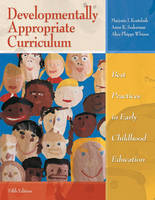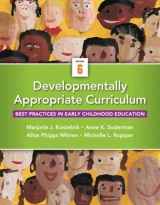
Developmentally Appropriate Curriculum
Pearson (Verlag)
978-0-13-703553-3 (ISBN)
- Titel erscheint in neuer Auflage
- Artikel merken
Concentrating as much on the “how” of curriculum development as on the “what and why,” the authors provide practical, research-based guidelines for translating theory into best practice that accommodates age-appropriateness, individual differences, and social and cultural diversity. Students learn how to conceptualize, plan, implement, and evaluate curriculum through detailed application opportunities in each chapter.
New Features to this Edition include:
Assignable activities online at MyEducationLab are meaningfully integrated into each chapter, with margin notes referring to videos, classroom artifacts, and strategies in “Assignments and Activities” and more applied exercises in “Building Teaching Skills and Dispositions”
New Developmentally Appropriate Practice definitions are incorporated throughout
Stronger focus on national curriculum standards
More emphasis on key topics such as circle time, structuring the environment, classroom arrangements, scheduling, and cultural variations in teaching
Thorough integration of children with special needs in every chapter, offering examples, case studies, and specific adaptations to activities
Stronger emphasis on intentional teaching, helping students prepare for the reality of classroom expectations
Marjorie J. Kostelnik is Dean of the College of Education and Human Sciences at the University of Nebraska, Lincoln. A former child care, Head Start, and preschool teacher, as well as elementary school specialist, Dr. Kostelnik has been actively involved in helping educators in early childhood programs explore the implications of developmentally appropriate practices. Her work has taken her to many settings throughout the United States and abroad. Marjorie teaches classes in early childhood inclusive education and is currently on the Coordinating Commission for High Quality Early Childhood Education for the state of Nebraska. Anne K. Soderman had 14 years of classroom experience working with children in both public and nonpublic educational settings prior to joining Michigan State University in 1979, where she is now Professor Emeritus. In addition to continuing to consult with schools in international settings, she is currently carrying out an administrative assignment and conducting research on second-language acquisition in Beijing, China. Soderman is also co-author of Guiding Children’s Social Development and Learning, 6th Ed. (2009), Creating Literacy-Rich Preschools and Kindergartens (2008) and Scaffolding Emergent Literacy (2005). Alice Phipps Whiren is a professor emeritus of the Department of Family and Child Ecology, Michigan State University. She taught curriculum in early childhood and child development to undergraduate and graduate students and was supervisor of the Child Development Laboratories. Early in her career, she taught young children in an inner-city public school in Michigan. She also served as a Head Start assistant director and has provided a variety of training sessions for preprimary teachers nationally and internationally.
Introduction
Part 1 Foundations of Early Childhood Education
Chapter 1Developmentally Appropriate Practice: An Evolving Framework for Teaching Young Children
Why Is There a Need for DAP?
The Early Childhood Profession Responds
General Practices Typically Associated with DAP
It Requires Judgment to Determine Developmental Appropriateness
DAP Has Historic Roots
There Is Empirical Support for Developmentally Appropriate Programs
DAP Programs Vary in Structure and Content
DAP Is Adaptable Across Program Settings
The High/Scope Approach to Early Childhood Education
The Reggio Emilia Approach to Early Childhood Education
The DAP Debate
What Does the DAP Debate Mean for Early Childhood Practitioners?
Implications of DAP for Professional Practice
Summary
Applying What You’ve Read in This Chapter
Practice for Your Certification or Licensure Exam
Chapter 2 Teaching and Learning in Developmentally Appropriate Programs
Early Childhood Educators Need to Know About Child Development and Learning
Early Childhood Educators Need to Know About Effective Teaching Strategies
Which Teaching Strategies Are Best?
Common Teaching Strategies
The Cycle of Learning
Linking the Cycle of Learning to Teaching
Teaching in the Zone of Proximal Development
Early Childhood Educators Need to Know About Content
Addressing Content in Early Childhood Education
Benefits of Standards
Challenges in Using Standards
Addressing the Challenges
Summary
Applying What You’ve Read in This Chapter
Practice for Your Certification or Licensure Exam
Part 2 Setting the Stage for Learning
Chapter 3 Planning and Implementing Effective Small-Group Activities
Why Plan?
Characteristics of Effective Planning
Planning Basics
Creating Developmentally Appropriate Plans
Aligning All the Parts of the Lesson Plan
Using Principles of Developmental Direction to Enhance Your Planning
Applying the Principles of Developmental Direction to Your Plans
Common Activities in Early Childhood Programs
Making and Implementing Plans
Summary
Applying What You’ve Read in This Chapter
Practice for Your Certification or Licensure Exam
Chapter 4 Planning and Implementing Effective Group-Time Activities
Planning Effective Group Times
Writing Group-Time Plans
Group-Time Preparations and Strategies
Variations on Traditional Group Times
Common Questions Practitioners Ask About Group Time
Adaptation of Whole-Group Instruction for Children of Different Ages and Abilities
Pitfalls to Avoid During Group-Time Planning
Summary
Applying What You’ve Read in This Chapter
Practice for Your Certification or Licensure Exam
Chapter 5 Organizing Space, Materials, and Time
Organizing the Physical Environment
Why Use Learning Centers?
Characteristics of Effective Early Childhood Learning Centers
Examples of Centers
Dealing with Implementation Issues
Adjusting the Physical Environment
Selecting Materials for Each Curricular Domain
General Guidelines for the Selection and Use of Materials
Using the Same Materials for Many Purposes
Creating a Daily Schedule
Sample Schedule
Summary
Applying What You’ve Read in This Chapter
Practice for Your Certification or Licensure Exam
Chapter 6 Child Guidance in Early Childhood Classrooms
What Children Need to Know
What Self-Discipline Is
How Self-Discipline Evolves
Degrees of Self-Discipline Among Children and Within the Same Child
Developmental Influences on Self-Discipline
How Experience Influences Self-Discipline
How Adult Discipline Styles Influence Children’s Self-Discipline
The Relation Between Authoritative Teaching and DAP
Authoritative Teaching and the Importance of Teamwork Among Staff
Questions Adults Ask About Promoting Self-Discipline in Children
Summary
Applying What You’ve Read in This Chapter
Practice for Your Certification or Licensure Exam
Chapter 7 Evaluating and Guiding Children’s Progress by Using Authentic Assessment
The Changing Face of Early Childhood Assessment
Responsible Early Childhood Assessment and Evaluation
Standardized Testing: What Part Should It Play in Evaluating Children’s Progress?
Placement of Young Children on the Basis of Test Results
The Concept of Authentic Assessment
Strategies for Assessment in the Early Childhood Classroom
Organization and Use of Authentic Assessment and Evaluation Data: Portfolios and Student-Led Conferences
Summary
Applying What You’ve Read in This Chapter
Practice for Your Certification or Licensure Exam
Chapter 8 Strengthening Developmentally Appropriate Programs Through Family Involvement
The Changing Nature of Family Involvement in Early Childhood Education
Barriers to Family Involvement
Characteristics of Effective Family Involvement
Effective Family Involvement Techniques
Summary
Applying What You’ve Read in This Chapter
Practice for Your Certification or Licensure Exam
Part 3 The Curriculum
Chapter 9 The Aesthetic Domain
Aesthetics Defined
The Arts Defined
Scope of This Chapter
Aesthetic Education for Young Children
Importance of Aesthetic Learning
Relationship Between Aesthetic Learning and Knowing
Children’s Acquisition of a Fundamental Knowledge Base for Aesthetic Development
Aesthetic Learning and the Teacher’s Role
Current Educational Issues
Purpose and Goals
Teaching Strategies
Pitfalls to Avoid
Approaches to Teaching the Arts
Activity Suggestions
Summary
Applying What You’ve Read in This Chapter
Practice for Your Certification or Licensure Exam
Chapter 10 The Affective Domain
Children’s Developing Self-Awareness and Sense of Competence
Children’s Acquisition of a Fundamental Knowledge Base for Affective Development
Children’s Stress Reactions in Response to Overwhelming Emotional Demands
Promotion of Healthy Self-Esteem in the Early Learning Environment
Current Educational Issues
Purpose and Goals for Affective Development
Affective Teaching Strategies
Activity Suggestions
Summary
Applying What You’ve Read in This Chapter
Practice for Your Certification or Licensure Exam
Chapter 11 The Cognitive Domain
Cognitive Maturation
Children’s Acquisition of a Fundamental Knowledge Base for Cognitive Development
National Expectations and Standards
Current Educational Issues
Purpose and Goals for the Cognitive Domain
Teaching Strategies
Activity Suggestions
Summary
Applying What You’ve Read in This Chapter
Practice for Your Certification or Licensure Exam
Chapter 12 The Language Domain
Oral Language Development
Children’s Acquisition of Literacy: Connections Among Oral Language, Phonological and Phonemic Awareness, and Emerging Reading and Writing
Integration of Language Experiences Across the Curriculum
Current Educational Issues
Purpose and Goals for the Language Domain
Teaching Strategies
Activity Suggestions
Summary
Applying What You’ve Read in This Chapter
Practice for Your Certification or Licensure Exam
Chapter 13 The Physical Domain
Physical Activity
Health, Safety, and Nutrition
Current Educational Issues
Purpose and Goals
Teaching Strategies
Activity Suggestions
Summary
Applying What You’ve Read in This Chapter
Practice for Your Certification or Licensure Exam
Chapter 14 The Social Domain
Social Skill Development
Socialization: Children’s Behavior and Adult Expectations
Social Responsibility
Social Studies
Relationship Between the Social Domain and Cognition
Current Educational Issues
Purpose and Goals
Teaching Strategies
Activity Suggestions
Summary
Applying What You’ve Read in This Chapter
Practice for Your Certification or Licensure Exam
Part 4 Integrating Curriculum
Chapter 15 Integrating Curriculum Through Pretend and Construction Play
Characteristics of Play
Pretend and Construction Play Across the Curriculum and in Development
Integration of Multiple Domains
Teachers’ Questions Regarding Pretend and Construction Play
Promotion of Play Skills
Summary
Applying What You’ve Read in This Chapter
Practice for Your Certification or Licensure Exam
Chapter 16 Integrating Curriculum by Using Themes and Projects
Defining Themes and Projects
How Themes and Projects Contribute to Children’s Concept Development
Additional Benefits for Children
Teachers’ Benefits
Program Effects
Pitfalls in Theme Teaching
Principles of Effective Theme Teaching
How to Create Thematic Units
Common Questions About Themes and Projects
Summary
Applying What You’ve Read in This Chapter
Practice for Your Certification or Licensure Exam
Appendix A Sample Lesson Plans
Appendix B Field Trips
Appendix C The Big, Big Turnip
References
Name Index
Subject Index
| Erscheint lt. Verlag | 3.6.2010 |
|---|---|
| Sprache | englisch |
| Maße | 216 x 276 mm |
| Gewicht | 1110 g |
| Themenwelt | Sozialwissenschaften ► Pädagogik ► Vorschulpädagogik |
| ISBN-10 | 0-13-703553-5 / 0137035535 |
| ISBN-13 | 978-0-13-703553-3 / 9780137035533 |
| Zustand | Neuware |
| Informationen gemäß Produktsicherheitsverordnung (GPSR) | |
| Haben Sie eine Frage zum Produkt? |
aus dem Bereich



